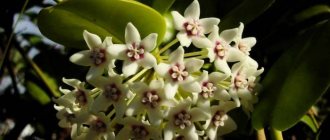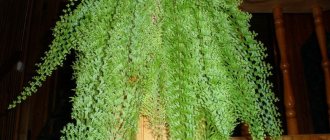Monstera care at home and pruning
Compared to other types of monstera, Alba is more demanding in terms of lighting and conditions. It grows slowly, it should be placed near western or eastern windows to avoid burning or being in the shade for a long time.
Basic rules for caring for Monstera variegata:
- To properly plant a monstera, you must place a drainage layer on the bottom of the pot. It is important to transplant the plant into a larger container in a timely manner (preferably in spring and summer) as its roots grow.
- Monstera feels comfortable at a temperature of 20-25°C, that is, room temperature. It is advisable to humidify the air, especially at higher air temperatures in the house, in order to bring the apartment conditions closer to natural ones. If the temperature drops, then you need to water less often;
- Fertilizing Monstera is necessary, but the plant is also quite demanding of it. Some experts believe that it is undesirable to use organic fertilizers so that the flower does not lose its color, so they feed the variegata with mineral fertilizers for ornamental plants, but reduce the concentration by 50%;
- if the monstera grows, it will need support. You can design it yourself or buy a ready-made coconut stick. It is worth wrapping the support with damp moss, to which the aerial roots are attached;
- Monstera should be watered with settled water. In terms of watering, this species is very capricious: you cannot either over-moisten the soil or allow it to dry out. The water should be at room temperature. If watering is too intense, dark spots form on the white areas of the plant’s leaves;
- Once every two weeks you should wash the plant under a warm shower or at least wipe the leaves with a damp cloth to remove dust from them. When using the first method, you should avoid getting tap water into the pot. This can lead to wilting of the vine.
How to form a monstera at home
Any owner of this “monstrous” flower sooner or later wonders how to prune Monstera variegata. This procedure is needed when the plant has grown greatly or vice versa, in order to accelerate its growth or provoke lush branching.
Important! Diseased or dead leaves should be trimmed.
The formation process is extremely simple: excess branches are cut off with clean scissors. To activate the growth of shoots, you should pinch off a small part and sprinkle the cut with ash.
For your information! Monstera is a poisonous plant, so you need to use gloves or, at a minimum, wash your hands thoroughly after the procedure.
What is a variegated monstera
The term "variegata" appears in the names of many plants. Their distinguishing feature is their variegation. This effect was achieved through certain mutations at the gene level. To understand how to properly care for such a plant and how variegated forms differ from others, you need to understand what variegation means.
The presence of white, pink or milky shades in the color of plants is due to the partial presence of chlorophyll-free cells in the genetic composition. They are the result of a mutation. Several genotypes are present in the cell tissues of such plants.
Attention! The nutrition and growth of variegated species is carried out only due to the presence of green parts of the plant. If white color dominates, the flower is not viable.
There are several varieties of monstera with variegated leaves. The most common is Alba - this is the flower that can most often be found in flower shops.
Aerial root care
Under natural conditions, Monstera is a powerful vine that entwines trees in tropical forests. In her homeland she was nicknamed a monster for the terrifying appearance of her huge shoots. This is precisely the reason for such a feature as the formation of aerial roots. These parts of the flower also need some care.
In its natural environment, Monstera is a powerful vine
Caring for aerial roots involves several options. You can apply in one of the following ways:
- Collect in a bunch and wrap in damp moss.
- Secure small containers to a support and lower the roots into them.
- Wrap the support in damp moss and press the shoots against it.
- When the required length is reached, root in a pot.
Attention! You cannot cut off the aerial roots of Monstera. This will partially deprive the plant of its ability to receive nutrients.
It is very convenient to use supports with a special coating. The roots can be pinned to it and this way it is more convenient to moisturize them. The option of placing the roots in containers with water also has a certain advantage - fertilizing can be dissolved directly in these containers. Thanks to this method, the plant will receive nutrients faster.
Growing Monstera in the form of a bush greatly simplifies the care of aerial roots. Since the shoots are located close to the surface of the pot, it is convenient to immediately root the roots as they grow.
Monstera variegata is an unusual and very decorative indoor plant. The large variegated leaves and powerful shoots of this tropical flower enchant and attract the eye. To decorate the interior and give it a piece of the atmosphere of the tropics - the variegated monstera will do this perfectly. Home care, pruning and propagation of this plant will not cause much trouble.
Liana propagation
There are several ways to propagate vines. Perhaps the best and most common method is propagation by stem cuttings. Step-by-step instruction:
- Cut the shoots so that at least one bud and one leaf remain on each of them.
- Dry the cut areas and sprinkle with charcoal powder. After this, 2-3 cuttings are planted in one pot, and the soil should contain perlite.
- The soil should not dry out, and the temperature in the house should be above 20°C. To make the cuttings take root faster, you need to cover them with a jar or bag. Sometimes this is a very long process that can take up to six months.
Propagation by air layering is not the easiest method to use at home, but it is more effective than others. One of its advantages is that nothing needs to be cut off from the monstera. You should find the shoot with the strongest and healthiest aerial roots on the plant and create moist conditions. To do this, you can wrap it with moss (attached with polyethylene), which must be constantly sprayed and watered.
Flower propagation
Propagation by apical cuttings involves cutting off the top of an adult monstera and placing the resulting cutting in a container of water. It is already possible to replant when three root shoots are formed on it.
Note! Variegata monstera has poisonous juices that are harmful to human skin. When working with them for a long time, there is a risk of getting burned. Therefore, you should always wear gloves.
In addition to the above methods, the flower can also be propagated by leaves and lateral shoots, but these methods are not so convenient and effective.
Thus, the variegated monstera is an excellent option for an apartment: it complements the interior and does not require special costs or maintenance. To keep it at home, you only need to observe the optimal conditions that were described in this article. The flower will reward you with an unusual and pleasing appearance and clean air in the house.
Caring for Monstera aerial roots
The aerial roots of Monstera are an inseparable and important part of the variegata; they cannot be cut off if they do not interfere in any way. If you nevertheless decide to remove them, then you need to reduce the length of the aerial roots by about half; they will temporarily stop growing.
The roots located lowest on the trunk should be directed into the soil if they reach it. This can be done by carefully tying them to the trunk of the plant. Some roots located higher up may even attach themselves to the wall.
Note! You can pour the settled water into several containers and place the roots there.
In general, by their nature, aerial roots are intended not so much for nutrition as for support. They, like all monsteras, need to be sprayed (this needs to be done about once a week), otherwise they will be the first to suffer if there is a lack of moisture.
What are they needed for
Aerial roots for indoor monstera are an additional tool for obtaining moisture: under natural conditions, this tropical plant grows in a climate zone where heavy warm rains often occur, and therefore the air is extremely saturated with moisture. Thanks to aerial roots, the vine can receive additional moisture not only from the soil, but also directly from the surrounding air, which is of great importance for the normal development and full life of the plant.
There is a direct relationship here: the more aerial roots a vine has, the more powerful, beautiful and healthy it will be. And under particularly favorable conditions, it can even please you with flowering. So aerial roots are certainly a necessary organ for a tropical beauty.
How to prune monstera
A mandatory care item for Monstera is pruning. The growth of the plant should be controlled to give it a neat shape and the required size. It is also necessary to pay attention to aerial roots.
Crown formation
Monstera easily tolerates pruning, and the cut off parts can be used as cuttings. This allows you to not only successfully propagate this flower at home, but also give it the desired shape.
The flower can be grown as a vine or maintained as a bush. The cutting technology depends on this.
Can be formed in the form of a vine or bush
Liana
As a rule, shaping is necessary for climbing specimens. It is performed step by step and involves several actions:
- Shortening shoots that are too long.
- Removing old unattractive leaves.
- Pruning shoots to stimulate branching.
Important! To make the flower look more decorative, it is better to plant 2 or 3 cuttings in one pot. Three powerful lashes with spreading leaves look very impressive. When forming several trunks, each of them requires separate support.
Bush form
Very often in flower shops you can see compact monsteras that look like a spreading bushy plant. Such specimens are usually more expensive, but this does not mean that amateur gardeners cannot create a plant of this shape on their own.
There are two ways that allow you to grow a monstera in the form of a bush:
- If an adult plant is used on a support, it is shortened as much as possible, and some of the cuttings are planted in the same pot.
- You can give the monstera this shape when planting cuttings. To do this, short tops with 1-2 aerial roots are planted in one pot.
Description of the plant
Monstera is an evergreen tropical crop of the genus Liana of the Araceae family, whose homeland is considered to be the southern regions of America. It has large, massive leaves in the shape of a heart with slits, the color of which is rich green, and may have spots, stripes of a lighter or yellow shade. Young leaves are devoid of slits: only with a certain age do they develop holes, which later transform into long slits.
The plant has a long stem from which roots can hang down. Under natural conditions, the height of an adult plant can reach 6 m, in domestic conditions - 4 m. It blooms in the form of a beige cob. After flowering is completed, it forms a fruit - a berry that is suitable for food. There are about thirty species of monstera in the world. In most cases, only a few are grown at home: monstera charma, lopsided or perforated.
Did you know? Many people mistakenly believe that the word “monstera” is translated as “monster, monster.” However, in fact, from Latin “monstrum” means “amazing, bizarre.”
Disease and pest control
The main causes of diseases in monstera:
- Parasites;
- Insufficient or excessive lighting;
- Waterlogging of the soil;
- Cramped pot;
- Unfavorable air temperature.
If a plant begins to develop white spots on its leaves, the disease is most likely caused by too much light. A twisted stem and small leaves indicate a lack of light. In such cases, it is recommended to move the plant to another corner of the house.
The appearance of droplets on the leaves and wilting of the plant indicate an excess of moisture. In this situation, it is necessary to stop watering and let the soil dry out. Insufficient watering leads to leaves falling off and brown spots appearing on them. The problem can be solved by increasing the frequency of watering.
When pests appear, monstera leaves should be wiped with a cotton swab dipped in a soap solution. High humidity has a detrimental effect on parasites, so the plant should be sprayed more often. Spraying should be combined with a decrease in air temperature - the plant can be left under the air conditioner for a while. Monstera can be treated with a 0.2% rogor solution. If no method helps get rid of parasites, it is necessary to cut off the affected parts of the flower.











